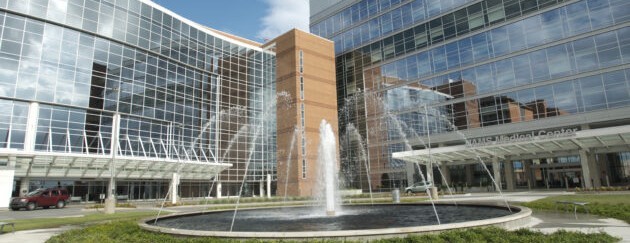Arkansas Commission on Child Abuse, Rape, and Domestic Violence Quarterly Newsletter

The Director’s Desk
Laura Robertson
Spring is finally in the air…along with pollen…but the days are getting longer, the flowers are blooming, and new beginnings are all around us! At ACCARDV, we are excited about some new beginnings too. In February, we were able to fund nine new programs focused on primary and secondary child abuse prevention. These new programs involve partners across all three of our areas of prevention focus; child abuse, sexual assault, and domestic violence. Each program is unique and will provide education or services that will aid in preventing child abuse in populations most at risk. As April begins and awareness is raised in our communities through Child Abuse Prevention Month and Sexual Assault Awareness & Prevention Month, we look forward to telling you a little about each of these new programs and their impact on Arkansas.
I have also enjoyed beginning visits to our Domestic Violence Shelters around the state with our Domestic Violence Coordinator, Sara Rudolph-Pollard. We have learned so much and have been so impressed with the services provided to the communities served in Fort Smith, Blytheville, West Memphis, Texarkana, and Little Rock. The part that impressed me most at every shelter was the tremendous support each of these agencies has from their cities and counties. That support says so much about the incredible work they do and the necessary services they provide to those experiencing domestic violence.
We look forward to continuing our visits around Arkansas in the coming months and meeting more of ACCARDV’s partners on the front lines of Domestic Violence prevention and survivor support.
The Child Welfare Ombudsman Division
I cannot believe that it has been fifteen months since the office of the Child Welfare Ombudsman opened. It has been full of meetings and partnering with stakeholders throughout the Child Welfare system, addressing issues within the system, and helping families and children receive the help and services they need while attempting to progress through an often confusing and overwhelming system.
One group I would like to highlight is our dependency-neglect attorney ad litems. These are attorneys that the court assigns to the children involved in a dependency-neglect case to represent the child’s best interest. Without a doubt, they have made my job much easier and more bearable on many days. Across the state, they take their jobs and their clients’ best interests very seriously. They genuinely care about the children they represent. Their care and concern show in their professionalism, legal expertise, and relentless pursuit of services for their clients and families, especially to prevent further abuse and strengthen the child’s family. They fight daily to make sure their clients whose parents’ rights are terminated are not lost to a system that can easily turn them into another statistic. These foster children are our most vulnerable, and our attorney ad litems represent them and their needs very well. Stasia McDonald, the Dependency-Neglect Attorney ad Litem Program Director for Arkansas, has done a fantastic job in the selection process across the state for attorney ad litems. The training and support her office provides the attorneys allow them to maintain consistent excellence in representing their clients that are often not seen in the legal profession.

ACCARDV Mission Statement
To enhance the investigation, prosecution, treatment, support and prevention on cases of child abuse, rape, and domestic violence. We hope that our services will help you educate and protect those whose lives are affected by these destructive realities, and replace confusion with clarity of purpose. The Commission’s purpose and membership were further defined in Act 1336, passed by the State Legislature in 1995. This comprehensive group is made up of representatives from various agencies, professions or groups, and service providers including law enforcement, medicine, and mental health.
Sexual Assault Prevention Division
As April is Sexual Assault Awareness and Prevention Month, I’m reminded that rape and sexual assault are unfortunately common in the United States and Arkansas. The National Sexual Violence Resource Center (NSVRC) reports that 81% of women and 43% of men reported sexual harassment and/or assault in their lifetime. In 2018, there were 2,950 rape and sexual assault reports across Arkansas. In 2019, the number of rape and sexual assault reports increased to 3,035. It is important to note that these statistics likely underestimate the actual number of rapes and sexual assaults. The NSVRC reports that 63% of sexual assaults go unreported. The Commission on Child Abuse, Rape, and Domestic Violence work with community partners to prevent rape and sexual assault and improve the quality of care for victims through educational programming and conferences.
Through the Center for Disease Control and Prevention’s Rape education grant, we fund five sexual assault programs around the state. One of these partners works tirelessly to implement prevention programs for people with disabilities, who have a significantly higher victimization rate of rape and sexual assault. The programs implement evidence-informed rape and sexual assault prevention programming, which teaches secondary students how to recognize healthy and unhealthy relationships, the harms of gender stereotypes, and the importance of consent.
This year, the Commission is hosting a conference on hospital response to sexual assault. The goals of this conference are to reinforce existing treatment protocols for healthcare providers around the state, provide more information about the chain of custody of evidence gathered from rape exams, and educate providers about issues in health equity faced by various marginalized groups.
Finally, we are working with the Arkansas Department of Health to include the Sexual Violence question module for the 2023 Behavioral Risk Factor Surveillance System (BRFSS); this will provide data to understand better the state’s actual rate of rape and sexual assault. The BRFSS collects vital demographic data and identifies the populations of greatest need, thus helping to direct our efforts most effectively.

Among female victims of rape, 51.1% reported an intimate partner as the perpetrator, while 40.8% reported the perpetrator was an acquaintance. Among male victims, 52.4% reported being raped by an acquaintance, while 15.2% reported the perpetrator was a stranger.
National Sexual Violence Resource Center
Child Welfare Division
As Child Abuse Prevention and Awareness Month always brings to mind the one question that has been asked of me at almost every child maltreatment education session over the last two decades. No matter if the audience is a dozen Head Start employees in a colorful classroom in rural Arkansas, a bustling auditorium of hundreds of educators, or a seminar room filled with uniformed law enforcement- the question most often asked is some version of “How do we keep this from happening?”
How do we prevent child abuse and neglect? According to the Administration for Children and Families (ACF), promoting protective factors is the answer. As defined by ACF, protective factors are conditions or attributes in individuals, families, communities, or the larger society that mitigate or eliminate risk in families and communities, thereby increasing the health and well-being of children and families. Utilizing protective factors assists parents in finding resources, supports, and coping strategies to help them in parenting effectively, even when under stress.
UAMS recently provided the Commission with the opportunity to develop funding parameters for a grant to prevent child abuse and neglect. Utilizing the protective factors framework adapted from the Strengthening Families Framework developed by the Center for the Study of Social Policy, ACCARDV asked non-profits, state agencies, law enforcement, juvenile courts, and other programs to submit proposals to increase protective factors in local communities. The funded programs described in their applications how the development or expansion of proposed projects would contribute to the increase in protective factors in the communities served. The Arkansas Coalition Against Sexual Assault, two domestic violence shelters, four child advocacy centers, Restore Hope, and the Center for Arkansas Legal Services are recipients of the ACCARDV Child Abuse and Neglect Prevention Grants. For the first time in Commission history, programs in all three disciplines were funded by the same grant, encouraging collaboration and integration among professionals and programs working in child maltreatment, sexual assault, and domestic violence. The Commission was grateful for applications for the initial round of funding, and we look forward to working with these programs and shining a light on the work they do in their communities in the coming year.

Protective Factors Framework:
Nurturing and attachment
Knowledge of parenting and child and youth development
Parental resilience
Social connections
Concrete support for parents
Social and emotional competence of children
Domestic Violence Division
As Laura mentioned above, it is a great pleasure visiting the shelters. I enjoy seeing old faces and meeting new ones. As I listen to all that the shelter’s staff can accomplish, I am amazed that they do so much with so little. One constant that I hear over and over is “COMMUNITY.” The communities are stepping up and providing everything from shampoo to diapers to furniture and stoves. People in the communities also give their time to build playsets, paint and even take care of lawns. Check with the shelter in your community and offer your time and talents.
On another note, I provide domestic violence/Healthy Relationship training to the residents of Hoover Treatment Center. At Hoover, we always seem to have some discussion on, Why doesn’t she just leave? When I started in the DV field over 25 years ago, I asked the same question. The reasons victims stay are varied and many.
Why Do The Abused Stay?
-The victims lack knowledge or access to safety and support.
-The belief that two-parent households are better for children, despite the abuse.
-Unsupportive friends and family
-The victim feels that the relationship is a mix of good times, love, hope, manipulation, intimidation, and fear.
Fear of the batterer’s violence:
A victim’s chances of being killed or seriously injured increase by 75% when leaving a violent relationship.
Immobilization by psychological and/or physical trauma:
Victims are often too injured or too frightened to tell or escape.
Connection to the perpetrator through children:
Some stay in the relationship because of their beliefs and for their children’s need for the other parent or because of the abuser’s previous threats to flee with the children, have the children taken away, or harm them.
Belief in cultural, family, or religious values:
Support systems are not always supportive of a victim leaving the relationship or seeking help. Family or religious systems can pressure a victim into staying in a violent relationship.
Continual hope and belief that the violence will end or he will change:
Victims believe promises made by the batterer and want the violence to end, but not necessarily the relationship. Victims believe that they have the power to change the relationship for the better.
Belief batterer will commit suicide or engage in self-destructive behavior:
Many batterers threaten suicide or use any means necessary to place guilt and worry on the victim.
Lack of funds:
It costs approximately $1500 to set up a household in the first month without housing assistance. Public housing lists are long, sometimes over six months, and many do not qualify.
Lack of real alternatives for employment and financial assistance:
Domestic violence is the number one cause of loss of employment in the United States.
Source: https://www.domesticpeace.com/why-abused-stay
1 in 4 women and 1 in 7 men will experience domestic violence in their lifetime. For trans or gender non-conforming folks, this number jumps to 54% (National Center for Transgender Equality)
https://www.responding.org/dv-facts-stats/
1 in 3 adolescent girls in the US are victims of physical, emotional, or verbal abuse from a dating partner.
It takes an average of 7 attempts for a survivor to leave their abuser and stay separated for good. Leaving is the most dangerous time in an abusive relationship.
Each day in the US, three women are murdered by a current or former intimate partner (Bureau of Justice Statistics).
An intimate partner kills 1 in 5 homicide victims. Over half of female homicide victims in the US are killed by a current or former male intimate partner (CDC).
